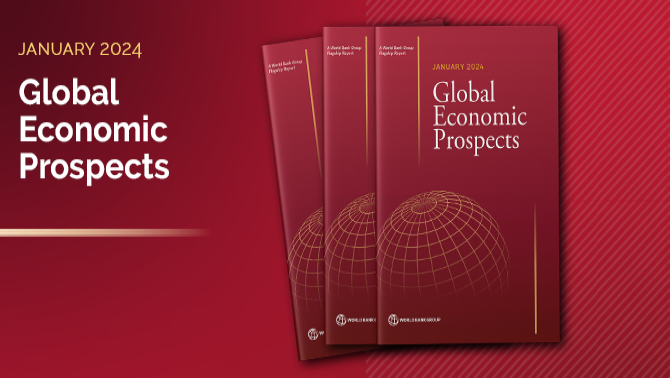Reforms to boost investment and strengthen fiscal policy could help turn the tide
Washington, January 9, 2024. According to the latest edition of the report Global economic prospects According to the World Bank, as the world approaches the halfway point of what was expected to be a transformative decade for development, the global economy is close to breaking an unfortunate record by the end of 2024: the five years of lowest GDP growth. GDP during the past three decades.
By one possible measure, the global economy is in better shape than it was a year ago: the risk of a global recession has decreased, largely due to the strength of the US economy. But rising geopolitical tensions may create new risks to the global economy in the near term. At the same time, the medium-term prospects for many developing economies have become bleak amid slower growth in most major economies, a slowdown in global trade, and tighter financial conditions in recent decades. Global trade growth in 2024 is expected to be half the average recorded in the decade before the pandemic. Moreover, borrowing costs for developing economies – especially those with weak credit ratings – are likely to remain high with global interest rates remaining at their highest levels in four decades in inflation-adjusted terms.
Global growth is expected to slow for the third year in a row, falling from 2.6% last year to 2.4% in 2024, nearly three-quarters of a percentage point below the 2000s average. According to forecasts, developing economies will grow by only 3.9%, less than one percentage point above the average recorded in the past decade. After last year's disappointing performance, low-income countries will grow by 5.5%, less than expected. By the end of 2024, the population of one in four developing countries and about 40% of low-income countries will remain poorer than they were before the COVID-19 pandemic. In advanced economies, growth is expected to slow in 2024 and move from 1.5% recorded in 2023 to 1.2%.
“Without a major course correction, the second decade of this century will go down in history as a decade of missed opportunities.”, Announce Indermeet Gill, economist President and First Vice President of the World Bank Group. “Short-term growth will remain weak and will lead many developing countries, especially the poorest, into a trap: stifling levels of debt and precarious access to food for almost one in three people. This would hinder progress on many global priorities. There are still opportunities to change course. This report offers a clear way forward, detailing the transformation that can be achieved if governments act now to accelerate investment and strengthen fiscal policy frameworks.
To address climate change and achieve other key global development goals by 2030, developing countries will need to significantly increase their investments by about US$2.4 trillion annually. In the absence of a comprehensive policy package, the prospects for an increase of this magnitude are not promising. Between 2023 and 2024, per capita investment in developing economies is expected to grow, on average, by just 3.7%, just over half the growth rate of the previous two decades.
The report provides the first global analysis of what it takes to achieve a sustainable investment boom, based on the experiences of 35 advanced economies and 69 developing economies accumulated over the past seventy years.. The report finds that developing economies often achieve unexpected economic gains when they accelerate per capita investment growth to at least 4% and sustain it for six years or more: the pace of convergence with advanced economies' income levels accelerates, and the poverty rate falls More quickly and productivity decreases. Growth quadruples and other benefits also accrue during these boom periods: among other things, inflation falls, financial and external conditions improve, and people's ability to access the Internet expands rapidly.
““Investment booms have the potential to transform developing economies and help them accelerate the energy transition and achieve a wide range of development goals.” said Ayhan Kose, Deputy Chief Economist and Director of the World Bank's Forecast Group.. “To foster these booms, developing economies must implement comprehensive policy packages aimed at improving fiscal and monetary frameworks, expanding cross-border trade and financial flows, improving the investment climate, and enhancing the quality of institutions. It's hard work, but many developing economies have managed to do it. Achieving this goal again will help mitigate the slowdown in growth expected for the rest of this decade.
In the latest version of Global economic prospects The report also points out what two-thirds of developing countries – especially commodity exporters – can do to avoid boom-bust cycles. He concluded that the governments of these countries usually adopt fiscal policies that intensify periods of booms and busts. When increases in commodity prices generate 1 percentage point of growth, for example, governments increase spending to generate an additional 0.2 percentage point of growth. Generally speaking, in good times, fiscal policy tends to overheat the economy, and in bad times, it tends to deepen recessions. These “cyclical fluctuations” are 30% stronger in commodity-exporting developing economies than in other developing economies. Fiscal policies also tend to be 40% more volatile in these economies compared to other developing economies.
Instability associated with increased procyclicality and volatility in fiscal policy constitute a chronic burden on the growth prospects of commodity-exporting developing economies. This burden can be alleviated by establishing a financial framework that helps control public spending, adopting flexible exchange rate systems, and avoiding restrictions on the movement of international capital. in the middle, These policies could help commodity exporting countries in developing economies increase per capita GDP growth by up to one percentage point every four to five years. Countries can also benefit from establishing sovereign wealth funds and other reserve funds that can be drawn quickly in emergency situations.
Download the full report
Regional Perspectives:
East Asia and Pacific: Growth is expected to slow to 4.5% in 2024 and 4.4% in 2025. For more information, see Regional panorama.
Europe and Central Asia: Growth is expected to decline to 2.4% in 2024 and then rise to 2.7% in 2025. For more information, see Regional panorama.
Latin America and the Caribbean: Growth is expected to rise to 2.3% in 2024 and 2.5% in 2025. For more information, see Regional panorama.
Middle East and North Africa: Growth is expected to rebound to 3.5% in 2024 and remain at that level in 2025. For more information, see Regional panorama.
South Asia: Growth is expected to slow to 5.6% in 2024 and rise to 5.9% in 2025. For more information, see Regional panorama.
Sub-Saharan Africa: Growth is expected to rebound to 3.8% in 2024 and continue to rise to 4.1% in 2025. For more information, see Regional panorama.
Website: https://www.bancomundial.org/es/publication/global-economy-prospects
Facebook: https://www.facebook.com/bancomundial
x (Twitter): http://www.twitter.com/bancomundial
Youtube: youtube.com/worldbank (Yo)





